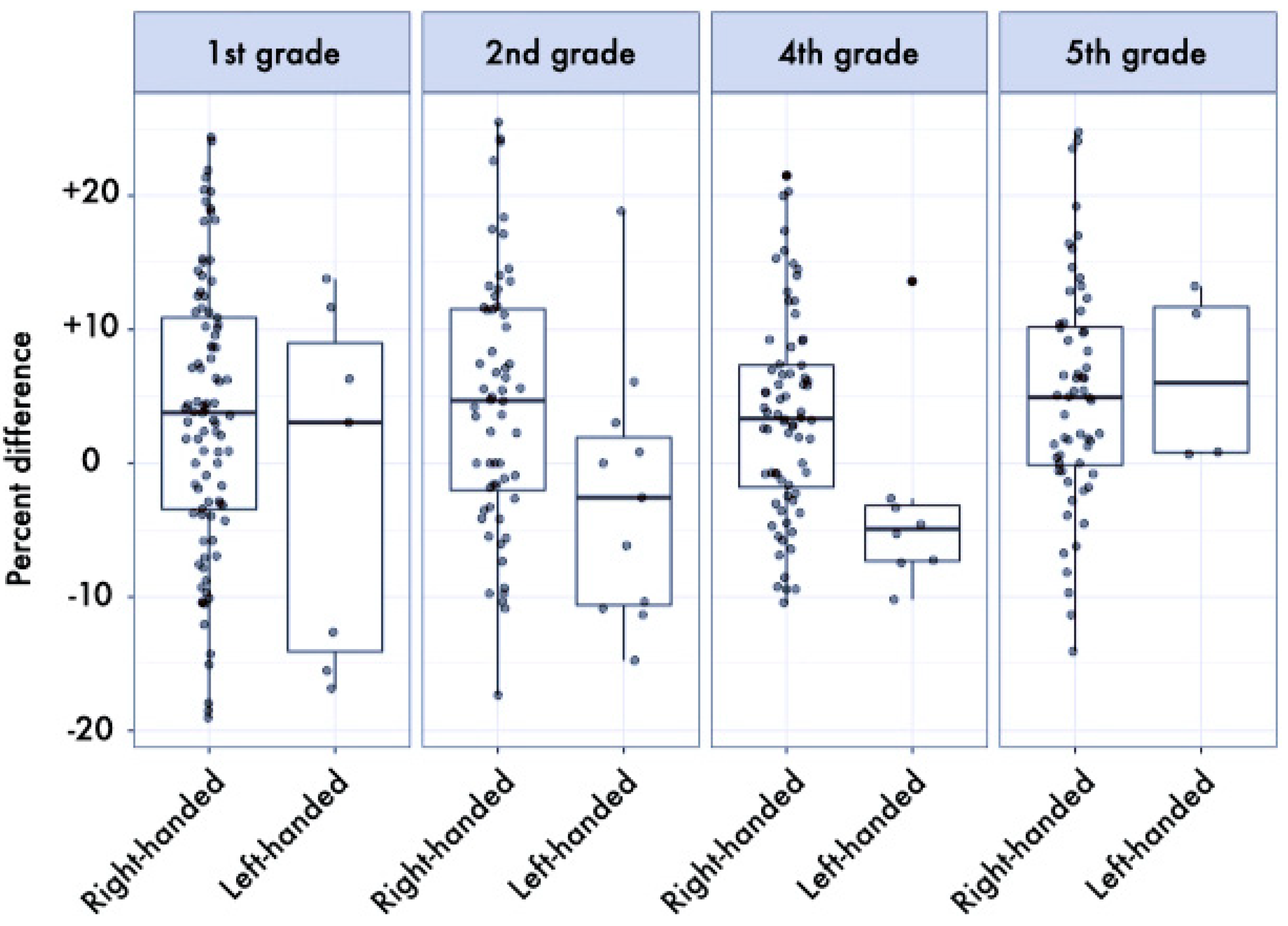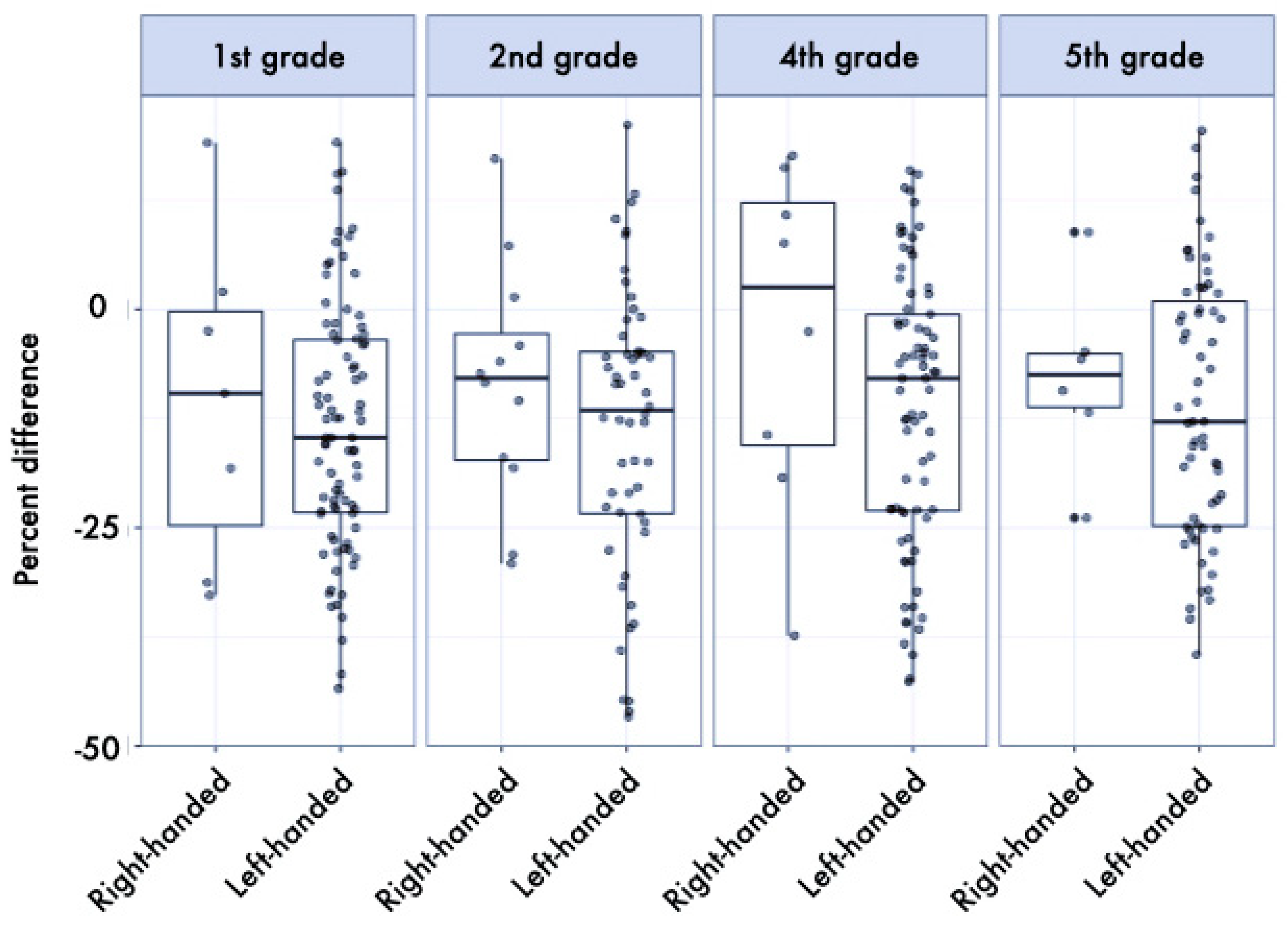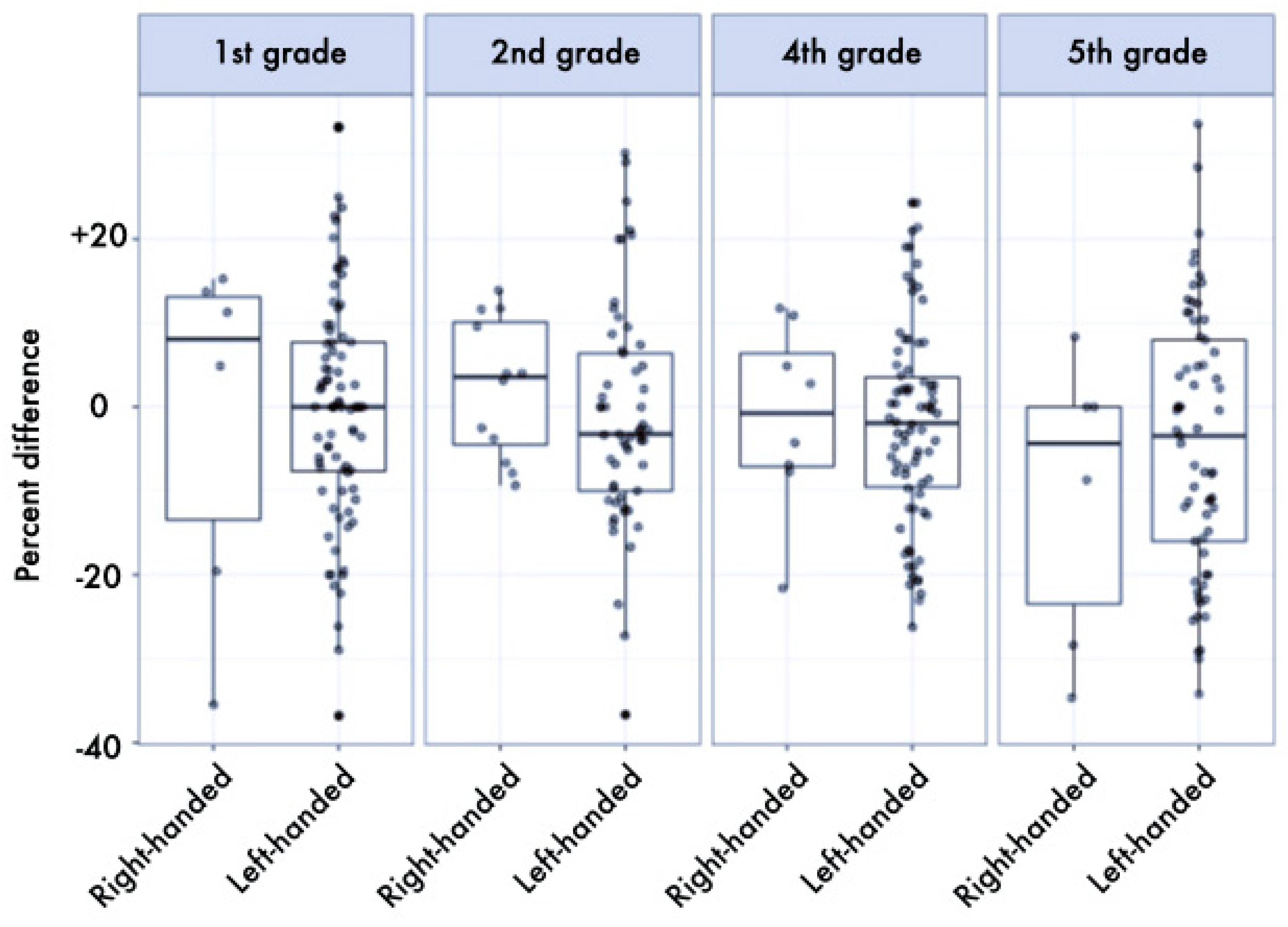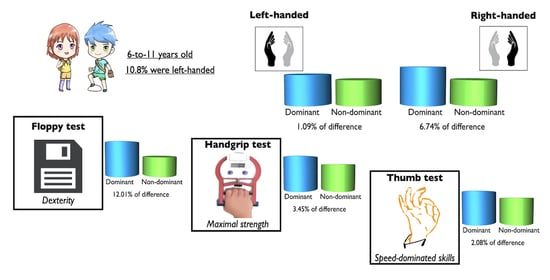Laterality in Children: Evidence for Task-Dependent Lateralization of Motor Functions
Abstract
1. Introduction
2. Materials and Methods
2.1. Design and Participants
2.2. Procedures
2.3. Data Analysis
3. Results
4. Discussion
5. Conclusions
Supplementary Materials
Author Contributions
Funding
Acknowledgments
Conflicts of Interest
References
- Güntürkün, O.; Ocklenburg, S. Ontogenesis of Lateralization. Neuron 2017, 94, 249–263. [Google Scholar] [CrossRef] [PubMed]
- Stancher, G.; Sovrano, V.A.; Vallortigara, G. Motor asymmetries in fishes, amphibians, and reptiles. Prog. Brain Res. 2018, 238, 33–56. [Google Scholar] [CrossRef] [PubMed]
- Corballis, M.C. Chapter 7—Evolution of cerebral asymmetry. In Progress in Brain Research; Hofman, M.A., Ed.; Evolution of the Human Brain: From Matter to Mind; Elsevier: Amsterdam, The Netherlands, 2019; Volume 250, pp. 153–178. [Google Scholar]
- Fagard, J. The nature and nurture of human infant hand preference. Ann. N. Y. Acad. Sci. 2013, 1288, 114–123. [Google Scholar] [CrossRef]
- Hepper, P.G.; Shahidullah, S.; White, R. Handedness in the human fetus. Neuropsychologia 1991, 29, 1107–1111. [Google Scholar] [CrossRef]
- Hepper, P.G.; McCartney, G.R.; Shannon, E.A. Lateralised behaviour in first trimester human foetuses. Neuropsychologia 1998, 36, 531–534. [Google Scholar] [CrossRef]
- de Kovel, C.G.F.; Carrión-Castillo, A.; Francks, C. A large-scale population study of early life factors influencing left-handedness. Sci. Rep. 2019, 9. [Google Scholar] [CrossRef] [PubMed]
- Marcori, A.J.; Grosso, N.d.S.; Porto, A.B.; Okazaki, V.H.A. Beyond handedness: Assessing younger adults and older people lateral preference in six laterality dimensions. Laterality 2019, 24, 163–175. [Google Scholar] [CrossRef] [PubMed]
- Gooderham, S.E.; Bryden, P.J. Does your dominant hand become less dominant with time? The effects of aging and task complexity on hand selection. Dev. Psychobiol. 2014, 56, 537–546. [Google Scholar] [CrossRef]
- Nelson, E.L.; Gonzalez, S.L.; El-Asmar, J.M.; Ziade, M.F.; Abu-Rustum, R.S. The Home Handedness Questionnaire: Pilot data from preschoolers. Laterality 2019, 24, 482–503. [Google Scholar] [CrossRef]
- Scharoun, S.M.; Bryden, P.J. Hand preference, performance abilities, and hand selection in children. Front. Psychol. 2014, 5. [Google Scholar] [CrossRef]
- Prete, G.; Tommasi, L. Chapter 10—Split-brain patients: Visual biases for faces. In Progress in Brain Research; Forrester, G.S., Hopkins, W.D., Hudry, K., Lindell, A., Eds.; Cerebral Lateralization and Cognition: Evolutionary and Developmental Investigations of Behavioral Biases; Elsevier: Amsterdam, The Netherlands, 2018; Volume 238, pp. 271–291. [Google Scholar]
- Crow, T.J.; Crow, L.R.; Done, D.J.; Leask, S. Relative hand skill predicts academic ability: Global deficits at the point of hemispheric indecision. Neuropsychologia 1998, 36, 1275–1282. [Google Scholar] [CrossRef]
- Rodriguez, A.; Waldenström, U. Fetal origins of child non-right-handedness and mental health. J. Child Psychol. Psychiatry 2008, 49, 967–976. [Google Scholar] [CrossRef]
- Tsuang, H.-C.; Chen, W.J.; Kuo, S.-Y.; Hsiao, P.-C. The cross-cultural nature of the relationship between schizotypy and mixed-handedness. Laterality 2013, 18, 476–490. [Google Scholar] [CrossRef] [PubMed]
- Upadhyay, N.; Mandal, M.K.; Asthana, A.K.; Sharma, H. Hand preference in patients with allergy, juvenile cancer, and schizophrenia. Laterality 2004, 9, 325–337. [Google Scholar] [CrossRef] [PubMed]
- Rodriguez, A.; Kaakinen, M.; Moilanen, I.; Taanila, A.; McGough, J.J.; Loo, S.; Järvelin, M.-R. Mixed-handedness is linked to mental health problems in children and adolescents. Pediatrics 2010, 125, e340–e348. [Google Scholar] [CrossRef]
- Markou, P.; Ahtam, B.; Papadatou-Pastou, M. Elevated Levels of Atypical Handedness in Autism: Meta-Analyses. Neuropsychol. Rev. 2017, 27, 258–283. [Google Scholar] [CrossRef]
- Darvik, M.; Lorås, H.; Pedersen, A.V. The Prevalence of Left-Handedness Is Higher Among Individuals With Developmental Coordination Disorder Than in the General Population. Front. Psychol. 2018, 9. [Google Scholar] [CrossRef]
- Malatesta, G.; Marzoli, D.; Apicella, F.; Abiuso, C.; Muratori, F.; Forrester, G.S.; Vallortigara, G.; Scattoni, M.L.; Tommasi, L. Received Cradling Bias During the First Year of Life: A Retrospective Study on Children With Typical and Atypical Development. Front. Psychiatry 2020, 11. [Google Scholar] [CrossRef]
- Malatesta, G.; Marzoli, D.; Tommasi, L. The association between received maternal cradling and neurodevelopment: Is left better? Med. Hypotheses 2020, 134, 109442. [Google Scholar] [CrossRef]
- Parma, V.; Brasselet, R.; Zoia, S.; Bulgheroni, M.; Castiello, U. The origin of human handedness and its role in pre-birth motor control. Sci. Rep. 2017, 7, 16804. [Google Scholar] [CrossRef]
- Michel, G.F.; Tyler, A.N.; Ferre, C.; Sheu, C.-F. The manifestation of infant hand-use preferences when reaching for objects during the seven- to thirteen-month age period. Dev. Psychobiol. 2006, 48, 436–443. [Google Scholar] [CrossRef] [PubMed]
- Sacrey, L.-A.R.; Karl, J.M.; Whishaw, I.Q. Development of rotational movements, hand shaping, and accuracy in advance and withdrawal for the reach-to-eat movement in human infants aged 6–12 months. Infant Behav. Dev. 2012, 35, 543–560. [Google Scholar] [CrossRef] [PubMed]
- Nelson, E.L.; Campbell, J.M.; Michel, G.F. Unimanual to bimanual: Tracking the development of handedness from 6 to 24 months. Infant Behav. Dev. 2013, 36, 181–188. [Google Scholar] [CrossRef] [PubMed]
- Longoni, A.M.; Orsini, L. Lateral Preferences in Preschool Children: A Research Note. J. Child Psychol. Psychiatry 1988, 29, 533–539. [Google Scholar] [CrossRef]
- McManus, I.C.; Sik, G.; Cole, D.R.; Mellon, A.F.; Wong, J.; Kloss, J. The development of handedness in children. Br. J. Dev. Psychol. 1988, 6, 257–273. [Google Scholar] [CrossRef]
- Annett, M. Handedness and Brain Asymmetry: The Right Shift Theory; Psychology Press: New York, NY, USA, 2002; p. 396. ISBN 978-1-84169-104-6. [Google Scholar]
- Häger-Ross, C.; Rösblad, B. Norms for grip strength in children aged 4-16 years. Acta Paediatr. 2002, 91, 617–625. [Google Scholar] [CrossRef]
- Fennell, E.B.; Satz, P.; Morris, R. The development of handedness and dichotic ear listening asymmetries in relation to school achievement: A longitudinal study. J. Exp. Child Psychol. 1983, 35, 248–262. [Google Scholar] [CrossRef]
- Petersen, P.; Petrick, M.; Connor, H.; Conklin, D. Grip Strength and Hand Dominance: Challenging the 10% Rule. Am. J. Occup. Ther. 1989, 43, 444–447. [Google Scholar] [CrossRef]
- Hepping, A.M.; Ploegmakers, J.J.W.; Geertzen, J.H.B.; Bulstra, S.K.; Stevens, M. The Influence of Hand Preference on Grip Strength in Children and Adolescents; A Cross-Sectional Study of 2284 Children and Adolescents. PLoS ONE 2015, 10, e0143476. [Google Scholar] [CrossRef]
- McGrath, R.L.; Kantak, S.S. Reduced asymmetry in motor skill learning in left-handed compared to right-handed individuals. Hum. Mov. Sci. 2016, 45, 130–141. [Google Scholar] [CrossRef]
- Mori, S.; Iteya, M.; Gabbard, C. Hand preference consistency and simple rhythmic bimanual coordination in preschool children. Percept. Mot. Ski. 2007, 104, 792–798. [Google Scholar] [CrossRef] [PubMed]
- Martzog, P.; Stoeger, H.; Suggate, S. Relations between Preschool Children’s Fine Motor Skills and General Cognitive Abilities. J. Cogn. Dev. 2019, 20, 443–465. [Google Scholar] [CrossRef]
- Palmis, S.; Danna, J.; Velay, J.-L.; Longcamp, M. Motor control of handwriting in the developing brain: A review. Cogn. Neuropsychol. 2017, 34, 187–204. [Google Scholar] [CrossRef] [PubMed]
- Marinsek, M. Lateral asymmetry as a function of motor practice type of complex upper- and lower-limb movement in young children. Laterality 2016, 21, 267–281. [Google Scholar] [CrossRef]
- Bondi, D.; Robazza, C.; Pietrangelo, T. The Assessment of Task-Dependent Manual Laterality in Second Grade Students. Turk. J. Sports Med. 2020. [Google Scholar] [CrossRef]
- Bala, G.; Golubović, Š.; Katić, R. Relations between Handedness and Motor Abilities in Preschool Children. Coll. Antropol. 2010, 34, 69–75. [Google Scholar] [PubMed]
- Stöckel, T.; Vater, C. Hand preference patterns in expert basketball players: Interrelations between basketball-specific and everyday life behavior. Hum. Mov. Sci. 2014, 38, 143–151. [Google Scholar] [CrossRef]
- Stöckel, T.; Weigelt, M. Plasticity of human handedness: Decreased one-hand bias and inter-manual performance asymmetry in expert basketball players. J. Sports Sci. 2012, 30, 1037–1045. [Google Scholar] [CrossRef]
- Ziyagil, M.A. Handedness and Footedness: Relations to Differences in Sprinting Speed and Multiple Sprints Performance in Prepubertal Boys. Percept. Mot. Skills 2011, 112, 440–450. [Google Scholar] [CrossRef] [PubMed]
- Baker, J.; Kungl, A.-M.; Pabst, J.; Strauß, B.; Büsch, D.; Schorer, J. Your fate is in your hands? Handedness, digit ratio (2D:4D), and selection to a national talent development system. Laterality 2013, 18, 710–718. [Google Scholar] [CrossRef]
- Sterkowicz, S.; Lech, G.; Blecharz, J. Effects of laterality on the technical/tactical behavior in view of the results of judo fights. Arch. Budo 2010, 6, 173–177. [Google Scholar]
- Schorer, J.; Tirp, J.; Steingröver, C.; Baker, J. Laterality and its role in talent identification and athlete development. In Laterality in Sports: Theories and Applications; Elsevier Academic Press: San Diego, CA, USA, 2016; pp. 87–105. ISBN 978-0-12-801426-4. [Google Scholar]
- Nuri, L.; Shadmehr, A.; Ghotbi, N.; Attarbashi Moghadam, B. Reaction time and anticipatory skill of athletes in open and closed skill-dominated sport. Eur. J. Sport Sci. 2013, 13, 431–436. [Google Scholar] [CrossRef]
- Loffing, F.; Hagemann, N.; Strauss, B.; MacMahon, C. Laterality in Sports: Theories and Applications; Academic Press: Cambridge, MA, USA, 2016. [Google Scholar]
- Bondi, D.; Robazza, C.; Russo, E.; Russo, P.; Pietrangelo, T. Monitoring physical and motor traits in Primary school: A local harmful situation for older children. J. Sports Med. Phys. Fitness 2020. [Google Scholar] [CrossRef]
- Bruininks, R.H.; Bruininks, B.D. Bruininks-Oseretsky Test of Motor Proficiency, 2nd ed.; AGS Publishing: Circle Pines, MN, USA, 2005. [Google Scholar]
- Ruiz, J.R.; Castro-Piñero, J.; España-Romero, V.; Artero, E.G.; Ortega, F.B.; Cuenca, M.M.; Jimenez-Pavón, D.; Chillón, P.; Girela-Rejón, M.J.; Mora, J.; et al. Field-based fitness assessment in young people: The ALPHA health-related fitness test battery for children and adolescents. Br. J. Sports Med. 2011, 45, 518–524. [Google Scholar] [CrossRef] [PubMed]
- Zhu, W. Sadly, the earth is still round (p < 0.05). J. Sport Health Sci. 2012, 1, 9–11. [Google Scholar] [CrossRef]
- Papadatou-Pastou, M.; Ntolka, E.; Schmitz, J.; Martin, M.; Munafò, M.R.; Ocklenburg, S.; Paracchini, S. Human handedness: A meta-analysis. Psychol. Bull. 2020, 146, 481–524. [Google Scholar] [CrossRef]
- Michel, G.F.; Nelson, E.L.; Babik, I.; Campbell, J.M.; Marcinowski, E.C. Multiple trajectories in the developmental psychobiology of human handedness. Adv. Child Dev. Behav. 2013, 45, 227–260. [Google Scholar] [PubMed]
- O’Regan, L.; Serrien, D.J. Individual Differences and Hemispheric Asymmetries for Language and Spatial Attention. Front. Hum. Neurosci. 2018, 12. [Google Scholar] [CrossRef]
- Moulton, E.; Galléa, C.; Kemlin, C.; Valabregue, R.; Maier, M.A.; Lindberg, P.; Rosso, C. Cerebello-Cortical Differences in Effective Connectivity of the Dominant and Non-dominant Hand during a Visuomotor Paradigm of Grip Force Control. Front. Hum. Neurosci. 2017, 11, 511. [Google Scholar] [CrossRef]
- Glazier, P.S.; Davids, K.; Bartlett, R.M. Dynamical systems theory: A relevant framework for performance-oriented sports biomechanics research. Sportscience 2003, 7. [Google Scholar]
- Bondi, D.; Di Sano, S.; Verratti, V.; Neri, G.; Aureli, T.; Pietrangelo, T. New Insight on Motor Behavior: The Link Between the Hopping Task and the Tracing Performance as Hint of Gross and Fine Motor Functions. Mot. Control 2020, 1, 1–16. [Google Scholar] [CrossRef] [PubMed]
- Collins, K.; Johnson, N.; Klawitter, L.; Waldera, R.; Stastny, S.; Kraemer, W.J.; Christensen, B.; McGrath, R. Handgrip Strength Asymmetry and Weakness Are Differentially Associated with Functional Limitations in Older Americans. IJERPH 2020, 17, 3231. [Google Scholar] [CrossRef] [PubMed]
- Wilson, P.H.; Ruddock, S.; Smits-Engelsman, B.; Polatajko, H.; Blank, R. Understanding performance deficits in developmental coordination disorder: A meta-analysis of recent research. Dev. Med. Child Neurol. 2013, 55, 217–228. [Google Scholar] [CrossRef] [PubMed]
- Tran, U.S.; Voracek, M. Footedness Is Associated with Self-reported Sporting Performance and Motor Abilities in the General Population. Front. Psychol. 2016, 7. [Google Scholar] [CrossRef]
- Ferrero, M.; West, G.; Vadillo, M.A. Is crossed laterality associated with academic achievement and intelligence? A systematic review and meta-analysis. PLoS ONE 2017, 12. [Google Scholar] [CrossRef]
- Ziyagil, M.A.; Dane, S. Distributions of handedness and footedness, and their interrelationships in a large young Turkish population: Sex-related differences. Neurol. Psychiatry Brain Res. 2009, 16, 79–82. [Google Scholar]
- Kirby, K.M.; Pillai, S.R.; Carmichael, O.T.; Van Gemmert, A.W.A. Brain functional differences in visuo-motor task adaptation between dominant and non-dominant hand training. Exp. Brain Res. 2019, 237, 3109–3121. [Google Scholar] [CrossRef]
- Ittyerah, M. Emerging Trends in the Multimodal Nature of Cognition: Touch and Handedness. Front. Psychol. 2017, 8. [Google Scholar] [CrossRef]
- Floegel, M.; Kell, C.A. Functional hemispheric asymmetries during the planning and manual control of virtual avatar movements. PLoS ONE 2017, 12. [Google Scholar] [CrossRef]



| Left-Preferent | Right-Preferent | |||
|---|---|---|---|---|
| Dominant | Non-Dominant | Dominant | Non-Dominant | |
| Ist grade | 11.35 (2.85) | 10.40 (1.18) | 10.60 (2.10) | 10.20 (2.03) |
| IInd grade | 11.85 (0.73) | 12.30 (2.30) | 12.10 (3.45) | 11.70 (2.70) |
| IVth grade | 14.85 (1.10) | 15.75 (2.90) | 15.80 (3.90) | 15.10 (4.00) |
| Vth grade | 15.80 (3.52) | 14.80 (1.58) | 17.90 (3.70) | 17.20 (3.60) |
| Left-Preferent | Right-Preferent | |||
|---|---|---|---|---|
| Dominant | Non-Dominant | Dominant | Non-Dominant | |
| Ist grade | 22.90 (2.43) | 27.33 (10.26) | 22.30 (4.58) | 25.13 (5.08) |
| IInd grade | 21.30 (2.97) | 23.00 (4.73) | 19.30 (3.92) | 22.96 (5.05) |
| IVth grade | 18.00 (3.43) | 19.46 (1.85) | 17.05 (3.19) | 19.24 (4.05) |
| Vth grade | 16.51 (3.79) | 17.69 (1.73) | 16.94 (3.20) | 18.80 (4.16) |
| Left-Preferent | Right-Preferent | |||
|---|---|---|---|---|
| Dominant | Non-Dominant | Dominant | Non-Dominant | |
| Ist grade | 4.60 (1.49) | 4.20 (1.30) | 4.50 (1.31) | 4.63 (1.53) |
| IInd grade | 3.32 (0.69) | 3.15 (0.90) | 3.60 (1.13) | 3.70 (1.10) |
| IVth grade | 2.66 (0.49) | 2.90 (0.61) | 2.86 (0.90) | 2.96 (0.88) |
| Vth grade | 2.33 (0.20) | 2.44 (0.60) | 2.50 (0.66) | 2.60 (0.76) |
| Left-Preferent | Right-Preferent | |||||||
|---|---|---|---|---|---|---|---|---|
| LJ | 4 × 10 SR | HS | Floppy | LJ | 4 × 10 SR | HS | Floppy | |
| 4 × 10 SR | −0.272 | — | −0.539 *** | — | ||||
| HS | −0.127 | −0.554 ** | — | 0.433 *** | −0.276 *** | — | ||
| Floppy | −0.387 * | 0.123 | −0.328 | — | −0.171 ** | 0.218 *** | −0.512 *** | — |
| Thumb | −0.084 | 0.332 | −0.348 | 0.348 | −0.304 *** | 0.361 *** | −0.564 *** | 0.539 *** |
© 2020 by the authors. Licensee MDPI, Basel, Switzerland. This article is an open access article distributed under the terms and conditions of the Creative Commons Attribution (CC BY) license (http://creativecommons.org/licenses/by/4.0/).
Share and Cite
Bondi, D.; Prete, G.; Malatesta, G.; Robazza, C. Laterality in Children: Evidence for Task-Dependent Lateralization of Motor Functions. Int. J. Environ. Res. Public Health 2020, 17, 6705. https://doi.org/10.3390/ijerph17186705
Bondi D, Prete G, Malatesta G, Robazza C. Laterality in Children: Evidence for Task-Dependent Lateralization of Motor Functions. International Journal of Environmental Research and Public Health. 2020; 17(18):6705. https://doi.org/10.3390/ijerph17186705
Chicago/Turabian StyleBondi, Danilo, Giulia Prete, Gianluca Malatesta, and Claudio Robazza. 2020. "Laterality in Children: Evidence for Task-Dependent Lateralization of Motor Functions" International Journal of Environmental Research and Public Health 17, no. 18: 6705. https://doi.org/10.3390/ijerph17186705
APA StyleBondi, D., Prete, G., Malatesta, G., & Robazza, C. (2020). Laterality in Children: Evidence for Task-Dependent Lateralization of Motor Functions. International Journal of Environmental Research and Public Health, 17(18), 6705. https://doi.org/10.3390/ijerph17186705








